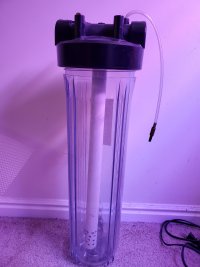I have not tried this yet, but I think it is very possible. The goal is to have a Calcium and Magnesium rich water free from any Cl, S, NO3, CO3 etc. this is how it could possibly be done: We will need Calcium and Magnesium Nitrate, we can also add KNO3 in there which will add K if you want.
We will have to pass the water through something similar to Plenum or anoxic filter and have it hooked up to the container that you use to gather your RO water which can be used to change the water of your aquarium. We can do the same to the tap water as well but RO water will benefit the best from such setup. This setup will remove most of the NO3 and we can hope to achieve 0-5 ppm NO3 at the end. You can aim for whatever Ca, Mg, K levels and ignore the NO3 at this time, which will leave the system as nitrogen gas giving you very low to zero reading on NO3 levels.
Now you can use this water for your aquarium, which is free from S, Cl, CO3 etc..
We will have to pass the water through something similar to Plenum or anoxic filter and have it hooked up to the container that you use to gather your RO water which can be used to change the water of your aquarium. We can do the same to the tap water as well but RO water will benefit the best from such setup. This setup will remove most of the NO3 and we can hope to achieve 0-5 ppm NO3 at the end. You can aim for whatever Ca, Mg, K levels and ignore the NO3 at this time, which will leave the system as nitrogen gas giving you very low to zero reading on NO3 levels.
Now you can use this water for your aquarium, which is free from S, Cl, CO3 etc..



